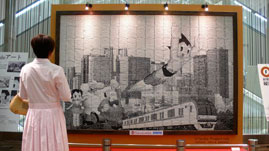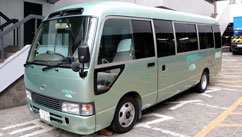 |
|
|
|
|
Where The East Has an Edge. by Richard Seireeni, Brand Architect January 6, 2008 |
||||
Many pioneering eco-capitalists have been betting that climate change will produce new opportunities for businesses that have the foresight to adopt earth-friendly manufacturing practices and/or create the products needed to propel the world toward sustainability. This awareness is fairly clear in Europe and North America where the majority of multi-national corporations call home. But what about Asia, where most of the world's goods are now made and whose growing economies further challenge the environment? The evidence that many companies are addressing the issues of pollution and climate change can be easily seen in Europe and now in the U.S. The following AP report released on November 30, 2007 is an example, "Some of the world's top business leaders are demanding that international diplomats meeting (at the UN Climate Change Conference in Bali) come up with drastic and urgent measures to cut greenhouse gas pollution at least in half by 2050. Officials from more than 150 global companies — worth nearly $4 trillion in market capitalization — have signed a petition urging "strong, early action on climate change" when political leaders meet in Indonesia. The hastily prepared petition drive, coordinated through the environmental office of Britain's Prince Charles, is signed by leaders from mainstream powerhouse companies such as Shell UK, GE International, Coca-Cola Co., Dupont Co., United Technologies Corp., Rolls Royce, Nestle SA, Unilever, British Airways and Volkswagen AG." I think more than altruism is at work here. These companies see revenue in the coming Age of Sustainability. So, where does Asia's manufacturing muscle fit in? I believe Asia is poised to make great economic gains from the worldwide movement toward sustainability for a number of reasons: — Asia's manufacturing agility and lower production costs make it easier to satisfy emerging demand for new earth-friendly products. As we've seen with the auto industry, they can turn on a dime when necessary. — Asia's people, more than those of the US and Europe, are feeling the direct effects of pollution, climate change and high oil prices, and are more likely to counter these effects because it is in their own best interests to do so. This is especially true when it comes to petroleum and clean water, both of which are in short supply in most Asian countries. Consequently, they are earnestly looking for renewable alternatives to the first and conservation measures for the second. — Conservation is etched into the social fabric of most Asian countries because dense populations and limited resources force its people to do more with less. Although Western news reports tend to focus on Asia's Nouveau Riche and their conspicuous consumption, the vast majority of Asians are poor and live modestly. Improvements to life are measured more in terms of improved life expectancy and access to basic needs, rather than the availability of discretionary luxuries — and this not likely to change in the near term. — Contrary to Western Christian traditions that have celebrated man as the apex being and encouraged exploitation of the land to his betterment, Buddhist, Taoist and Shinto traditions have defined a more symbiotic relationship between man and his environment. While its difficult to find these principles at work in the Three Gorges Dam or in the monocrop agriculture of Indonesia or in the gold mines of Papua, these traditions do lie beneath the surface and can be leveraged in arguments for costly environmental and CSR programs. — Most Asian societies celebrate a deep respect for the authority of elders and standing within the society. In China, the roots of this tradition can be found in Confucianism. This enables authorities, like the Communist Party in China, to make immediate and sweeping demands of its citizenry. While Western democracies tend to produce incremental and politically balanced compromises, Asian nations can and frequently do make sudden and extreme decisions that are, for the most part, obediently followed. China's one-child policy is a case in point. — Social standing, respect and conformity are also important, so Asian governments and Asian businesses can be responsive to potential embarrassment or shame. The recent back down by Japan's whaling fleet in Antarctic waters is an example of where the damage to image was not worth business gains. So, let's a take a quick look at a few industries where Asia can and should excel. Toys: The recent Mattel scandal over lead paint on toys should be seen as an opportunity to make toys that parents are not afraid of. According to an Opinion Dynamics poll sponsored by Fox News, "the 'China' brand has been weakened by the many recent stories about unsafe products," with many parents shunning Chinese-made toys altogether. Getting the lead out is relatively easy assuming China and other Asian manufacturing countries can ban lead in paint for ALL uses. But the way to turn the corner on this issue would be to remove PVC and all the plastic softening agents (phthalates) from the toy manufacturing process. Although the data linking plastic off-gassing to children's health has not been definitively proven, enough parents (and the European Union) are worried about it that an outright ban by Asian toy manufacturers would be viewed as positive and dramatic. According to the California EPA, the adverse health effects of phthalates include early puberty in girls, premature delivery, sperm damage, and genital defects and reduced testosterone production in boys. They go on to say that children are most at risk although contamination in the population at large has reached harmful levels. However, according to a report from the University of Massachusetts commissioned by Greenpeace, "For the toy industry, PVC is not a major material. It represents only 4.5% of plastics use in toys. For the PVC industry, the use of PVC in toys represents a minute proportion of PVC product." So, the risk is high and the solution appears relatively painless. Asian toymakers — who supply over 75% of the world's toys — could completely eliminate PVC, which is the most harmful plastic throughout its cradle-to-grave lifecycle, and eliminate the harmful and smelly softening agents needed to make PVC toys pliable. In one move, they could increase their export brand value while reducing long term health risks to workers and their local environment. Construction Materials & Furniture: China and some Southeast Asian nations are already ahead of the game by hosting companies that make furniture and other home furnishings from renewable materials, like bamboo, sorghum (Kirei Board), seagrass, natural latex, natural down and feathers, and use recycled steel and water-based glues. China has also taken the lead by adopting the EU's more strict rules on formaldehyde-free adhesives in the manufacture of plywood and laminates. So, while the growth of Asian economies is associated with a ravaging of the earth's resources to fuel their growth, there are rather dramatic counter-trends. One of the most visible is the wave of sustainable town planning most notable in China and India. "The word "sustainable" is not often used to describe the pollution-choked cities of Asia, but the continent is poised to host a new generation of green cities that right the wrongs of industrial-era urban planning," according to David Sokol in a recent article in Architectural Record. Indeed, combining new green technologies with more passive principals, like mass-transportation and high-density residential communities, should encourage the growth of a domestic green building materials industry that can then be exported to the rest of the world. Alternative Energy: As mentioned, petroleum is in short supply throughout Asia; and, the recent worldwide competition for oil is driving the price ever high, which threatens Asia's economic miracle. The primary alternatives — aside from coal, hydro and nuclear — are solar and wind. Both require advanced manufacturing in high numbers and at low cost to make these renewable energy alternatives viable. Throughout Asia, solar manufacturers are stepping up production. Sharp Electronics, of Japan, is one of the largest of these manufacturers producing as much generating capacity as the next three manufacturers combined. In a recent article in ZDNET News, solar makers will be producing "1,000 megawatts a year per factory, which is about how much electricity gets produced by a coal or nuclear plant." A new report from Global Sources says, "nearly 90 percent of solar panel manufacturers in Greater China plan to lower or keep prices stable, despite higher polysilicon prices, to win marketshare." An analogy can be made to the microprocessor industry that dramatically increased chip power while lowering cost and increasing production. The same is happening for photovoltaic panels. While this is going on, China is making a huge breakthrough in wind power technology according to Renewable Energy Access. "Chinese developers unveiled the world's first full-permanent magnetic levitation (Maglev) wind power generator at the Wind Power Asia Exhibition held June 28, 2006 in Beijing. When compared with the operational hours of existing wind turbines, the new technology will add an additional 1,000 hours of operation annually to wind power plants in areas with an average wind speed of 3 m/s. This is regarded as a key breakthrough in the evolution of global wind power technology and a notable advance in independent intellectual property rights in China." We could add other industry case studies to this list, but suffice it to say that Asia is well positioned to be a major player in the creation of earth-friendly products and technologies. They certainly see the need. They have the management skills, labor resources and industrial capacity to meet the demand. And the process of international technology exchange makes it a virtual certainty that any proprietary technologies will be shared with Asian partners to ensure a swift delivery to worldwide markets. A version of this article first appeared at Greenbiz.com. © Rick Seireeni, Brand Architect and President The Brand Architect Group is a strategic brand consultancy with offices in Los Angeles, Tokyo and Shanghai. Project specialties include retail, food service, banking and real estate development.
|
In the Shinto realm, the fox deity known as Kitsune is often clothed in red bibs. The fox is the messenger of Inari, the deity of food, farmers, and the rice harvest. Reverence for the fox as a messenger from nature is likely to have originated in India and then passed through China and Korea and ultimately to Japan.
An Astro Boy mural displayed at a Tokyo department store used tens of thousands of recycled subway tickets.
Toyota has been running hybrid busses in Japan for a while. I wonder when this vehicle will be brought to the states? Articles by Richard Seireeni:
|
![]()



